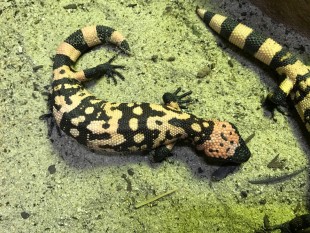Banded Gila Monster
Gila monsters are named for the Gila River Basin in Arizona where they were first discovered. Despite having “monster” in their name and being one of only a few venomous lizards in the world, Gila monsters are generally harmless and spend their time basking in the sun surrounded by cacti and other desert foliage.
Range & Habitat
Gila monsters can be found in the desert grasslands of the South Western United States and Northwestern Mexico. Gila monsters can also be found in canyon bottoms and arroyos (dry creeks).
Conservation Status: Near Threatened
Near Threatened. Gila monsters face the threat of increased habitat destruction due to urbanization and agricultural development. The illegal pet trade also threatens the wild population.
Diet
In the Wild – bird eggs, nesting rodents and rabbits, frogs, lizards, insects, centipedes, worms.
At the Zoo – small rodents.
Life Span
Fun Facts about the Banded Gila Monster
- Gila monsters have small pebble like scales with a pattern of colored scales that can be yellow, orange or pink.
- Gila monster tails are short and fat. They help with balance, but also store fat so the Gila monster can go longer periods of time between meals.
- Gila monsters produce venom in glands located in their lower jaw and channel it along grooves in their teeth. Although their venom has proved non-lethal to humans, their bite can be extremely painful.
- Gila monsters spend around 95 percent of their time under-ground.
Sources
Hammerson, G.A., Frost, D.R. & Gadsden, H. 2007. Heloderma suspectum. The IUCN Red List of Threatened Species 2007: e.T9865A13022716. http://dx.doi.org/10.2305/IUCN.UK.2007.RLTS.T9865A13022716.en. Download ed on 17 July 2017. • National Geographic. (n.d.). Gila Monster. Retrieved July 17, 2017, from http://www.nationalgeographic.com/animals/reptiles/g/gila-monster/ • Stewart, M. D. (2003). Heloderma suspectum (Gila Monster). Retrieved July 17, 2017, from http://animaldiversity.org/accounts/Heloderma_suspectum/#behavior • Potter Park Zoo, retrieved August 14, 2017,from www.potterparkzoo.org/our-animals/reptilesamphibians/gila-mons



